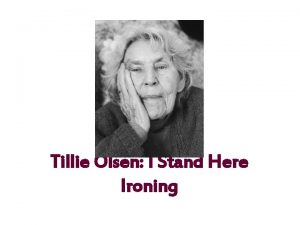Tillie Olsen Source www as ysu edu Tillie








- Slides: 8

Tillie Olsen Source: www. as. ysu. edu Tillie Lerner Olsen was the daughter of Russian Jewish immigrants who settled in Nebraska. Her father was a socialist, and in 1934, Tillie was jailed for handing out communist pamphlets to packinghouse workers. She was arrested with Jack Olsen, also a member of the Young Communist League. She began living with him in 1936. They had three daughters, and married in 1944 just before Jack left to join the military. Always politically active, Olsen’s best stories reflect her political and feminist views. Tillie in the 1940’s; photographer unknown; source: www. tillieolsen. net/

Always an Activist With her political activism and raising four daughters (one was Jack’s from a previous relationship). Olsen found it hard to write. She wrote on scraps of paper, at whatever times she could find. In the 1980’s Olsen (left) joined others at Stanford University in protesting apartheid. Source: news-service. stanford. edu In 1956 she was awarded a Stegner Fellowship to Stanford, which saved her literary career. Tell me a Riddle (1961), a collection of short stories, contained “I Stand Here Ironing. ” Her 1978 book, Silences, “describes the political, cultural and personal circumstances that hinder creative expression and questions why some voices, including those of women, historically had been silenced or become lost, is regarded as a foundational work in the fields of women's studies and feminist criticism” (Palmer, Barbara; newsservice. stanford. edu)

1930’s: the Great Depression In October of 1929, the New York stock market crashed. Overheated from speculation, with an economy which was overly centered on the automobile, and a recently passed tarrif which inhibited free trade (the Smoot-Hawley Act), the American economy could not recover from the loss of so much capital in the “crash of ’ 29. ” A conservative Republican who believed in free market capitalism, President Hoover did not believe that the federal government should intervene in the economic collapse: “It is not the function of the government to relieve individuals of their responsibilities to their neighbors, or to relieve private institutions of their responsibilities to the public” (www. Historyl earningsite. co. uk). He believed, and often said, “Prosperity is just around the corner. ” However, between the crash and Dec. 1930, 1300 banks had closed (www. lrgs. org. uk) and the number of unemployed had more than doubled. Unemployed worker in Detroit. Source: www. reuther. wayne. edu

Families in the Depression Statistics mirror the deepening anxiety of the Great Depression: In 1929, of 49, 440, 000 workers, 1, 550, 000 (or 3. 14%) were unemployed. In 1930, with 50, 080, 000 workers, 4, 340, 000 (or 8. 67%) were unemployed. By 1931, the unemployed were 15. 82%; by 1932, the unemployed were 23. 53%. (Source: www. u-s-history. com) This photo became an icon of the Great Depression. This 1936 photo, from the Farm Security Administration, shows a destitute mother of seven children, a family of pea-pickers in California. Source: The Franklin D. Roosevelt Library and Museum: www. fdrlibrary. marist. edu

FDR’s New Deal Elected by a landslide in 1932, Franklin Delano Roosevelt created program after program to deal with American’s unemployed. His first program was the Civilian Conservation Corps (CCC), enacted in March, 1933. At the time, the unemployment rate was 24. 9%. Through the CCC, “ 2. 5 million out-of-work, physically fit, unmarried, young men aged 18 to 25 found employment” (www. marist. edu). Men were paid at least $30 a month, but had to send $25 of it home. Civilian Conservation Corps worked in Prince George’s County, Maryland. Source: www. aphis. usda. gov CCC road crew. (Source: www. npos. gov) FDR and part of his cabinet at a Civilian Conservation Corps camp in Virginia. Note that all of the boys are white. FDR had to allow southern states to segregate their CCC camps. (Source: newdeal. feri. org)

WPA One of Roosevelt’s “alphabet soup” programs to deal with the Depression was The Works Progress Administration (WPA), “an ambitious New Deal program, put 8, 500, 000 jobless to work, mostly on projects that required manual labor. With Uncle Sam meeting the payroll, countless bridges, highways and parks were constructed or repaired” (lcweb 2. loc. gov/wpaintro/intro 01. html). Roadwork was a standard feature of WPA programs; the above project was in North Carolina. (Source: www. ah. dcr. state. nc. us) The WPA didn’t only widen roads; it also employed writers and artists who went into schools, put on plays, or painted murals. This mural was pained by artist Michael Lenson in 1936 for the Essex Mountain Sanatorium in New Jersey (now demolished). (Source: www. mountainsanatorium. net)

Aid to Dependent Children The Roosevelt administration created federal welfare. Because so many men had deserted their families (as in Olsen’s story), DFR decided that it should be federal policy to help single mothers care for their children. Aid to Dependent Children (ADC) was passed by Congress as part of The Social Security Act of 1935. (It became titled “Aid to Families with Dependent Children” in 1960. ) The program ended in 1997 with the passage of Welfare Reform, replaced by Temporary Assistance for Needy Families (TANF). The caption for this photo, according to the FDR Library, is “Aid to dependent children keeps families together. " (Source: www. fdrlibrary. marist. edu) Photo right: East Side Baby Health Station, part of FDR’s New Deal. (Source: newdeal. feri. org)

“I was nineteen. It was the pre-relief, pre-WPA world of the depression. ” St. Francis Orphanage, New Haven, CT; source: www. sachem. org “World War I (1914 -1918) and the post-war period marked the beginning of the modern day orphan phenomenon. The new orphans more than ever before were the victims of unwed parents, immigration, abuse, neglect and abandonment. By 1930, the Great Depression took its toll. Parents who were unable to feed their children could drop them off at the church and pick them up when they were able to feed them again. Some children lived in orphanages for months at a time and then returned to their parents when circumstances changed. This gave rise to social welfare and government subsidies to the less fortunate. ” (“History of Orphanges”: www. legends. ca)














